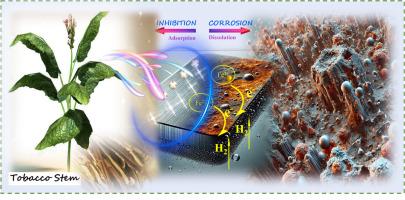Green corrosion inhibition: Tobacco stem extract and KI on steel in H₃PO₄ – experimental, modeling, and theoretical insights
IF 6.3
3区 工程技术
Q1 ENGINEERING, CHEMICAL
Journal of the Taiwan Institute of Chemical Engineers
Pub Date : 2025-08-23
DOI:10.1016/j.jtice.2025.106366
引用次数: 0
Abstract
Background
Tobacco stem extract (TSE) has shown promise as a corrosion inhibitor, but its time-dependent behavior and synergistic effects with potassium iodide (KI) in phosphoric acid remain underexplored. Given the tobacco stem waste in China, further research on the corrosion inhibition performance of TSE is crucial. This is particularly important for phosphoric acid systems, where the complex dissociation behavior and film instability pose distinct challenges for corrosion control.
Methods
The corrosion inhibition of TSE in combination with KI on cold rolled steel (CRS) in 5.0 M H₃PO₄ was evaluated using weight loss, potentiodynamic polarization, and electrochemical impedance spectroscopy (EIS). Surface morphology was analyzed using SEM and AFM, while TOF-SIMS and XPS were used to examine the chemical composition. LC-MS identified the active components in TSE, and quantum calculations, along with molecular dynamics simulations, provided insight into the adsorption mechanisms.
Significant Findings
Weight loss analysis demonstrated 92.9 % inhibition efficiency for TSE/KI at 20 °C. Electrochemical tests indicated that TSE/KI suppresses both anodic and cathodic reactions, forming a stable protective film. Surface characterization confirmed the inhibition effects. Key adsorption sites on TSE include nitrogen atoms and conjugated double bonds. These findings offer a deeper understanding of the synergistic mechanism between TSE and KI, providing valuable guidance for the development of eco-friendly, plant-based corrosion inhibitors. A novel mathematical model based on capacitance evolution was constructed using MATLAB to assess time-dependent electrochemical behavior. These findings provide mechanistic and predictive insights into the use of TSE/KI as a sustainable corrosion inhibitor in phosphoric acid environments.

绿色缓蚀:烟草茎提取物和KI对H₃PO₄钢的缓蚀作用——实验、建模和理论见解
烟草茎提取物(TSE)被认为是一种很有前景的缓蚀剂,但其在磷酸中的时间依赖性行为和与碘化钾(KI)的协同效应仍未得到充分研究。鉴于中国烟草废弃物的存在,进一步研究TSE的缓蚀性能至关重要。这对于磷酸体系尤其重要,因为磷酸体系复杂的解离行为和膜的不稳定性给腐蚀控制带来了明显的挑战。方法采用失重法、动电位极化法和电化学阻抗谱法评价TSE联合KI对5.0 M H₃PO₄中冷轧钢(CRS)的缓蚀作用。利用扫描电镜(SEM)和原子力显微镜(AFM)分析表面形貌,利用TOF-SIMS和XPS分析化学成分。LC-MS鉴定了TSE中的活性成分,量子计算和分子动力学模拟提供了对吸附机制的深入了解。减重分析表明,在20°C时,TSE/KI的抑制率为92.9%。电化学测试表明,TSE/KI能抑制阳极和阴极反应,形成稳定的保护膜。表面表征证实了其抑制作用。TSE的主要吸附位点包括氮原子和共轭双键。这些发现对TSE和KI之间的协同作用机制有了更深入的了解,为开发环保型植物基缓蚀剂提供了有价值的指导。利用MATLAB建立了一种基于电容演化的新型数学模型来评估电化学的时变行为。这些发现为TSE/KI在磷酸环境中作为可持续缓蚀剂的使用提供了机理和预测性见解。
本文章由计算机程序翻译,如有差异,请以英文原文为准。
求助全文
约1分钟内获得全文
求助全文
来源期刊
CiteScore
9.10
自引率
14.00%
发文量
362
审稿时长
35 days
期刊介绍:
Journal of the Taiwan Institute of Chemical Engineers (formerly known as Journal of the Chinese Institute of Chemical Engineers) publishes original works, from fundamental principles to practical applications, in the broad field of chemical engineering with special focus on three aspects: Chemical and Biomolecular Science and Technology, Energy and Environmental Science and Technology, and Materials Science and Technology. Authors should choose for their manuscript an appropriate aspect section and a few related classifications when submitting to the journal online.

 求助内容:
求助内容: 应助结果提醒方式:
应助结果提醒方式:


